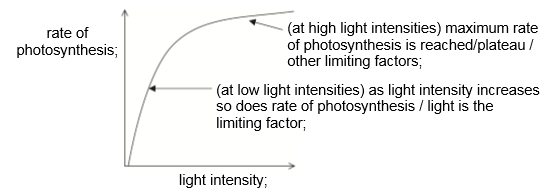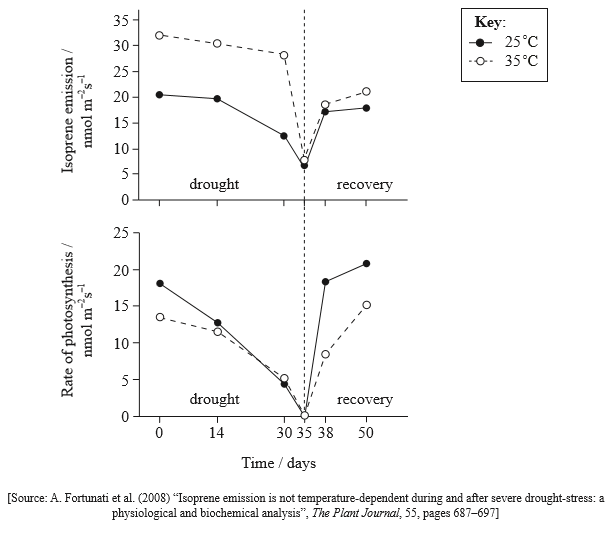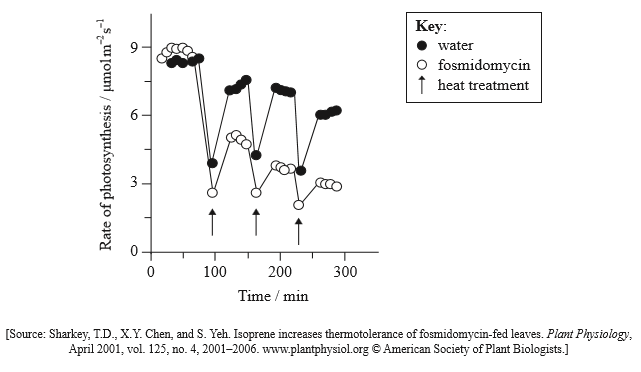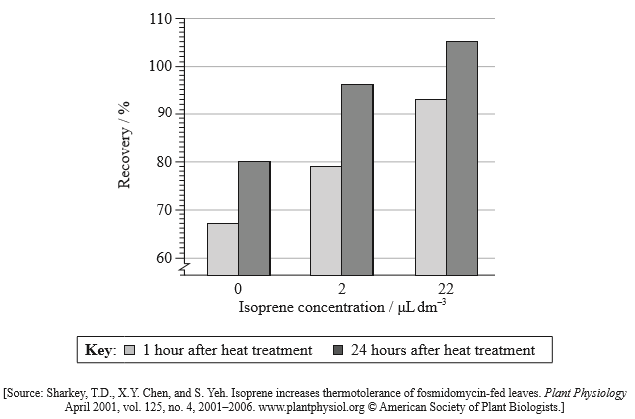Question
Describe the process of photolysis in photosynthesis.
▶️Answer/Explanation
Markscheme
a. water is split/breaks
b. using energy from light
c. electrons «from photolysis» pass to photosystem II
d. oxygen is a «waste» product
e. hydrogen ions/protons are produced
Allow answer given as an equation
[Max 3 Marks]
Question
In ecosystems, energy is used to convert inorganic compounds into organic matter. Energy enters ecosystems through producers.
Explain the processes by which light energy is converted into chemical energy.
Describe how energy flows through and is used by organisms in ecosystems.
▶️Answer/Explanation
Markscheme
a. plants/producers/autotrophs convert light to chemical energy by photosynthesis
b. chlorophyll/photosynthetic pigments absorb light
c. electrons are excited/raised to higher energy level
d. excited electrons pass along chain of electron carriers
e. energy from electrons used to pump protons across thylakoid membrane/into thylakoid space
f. chemiosmosis/proton gradient used to make ATP
g. ATP synthase generates ATP
h. pigments arranged in photosystems
i. electrons from Photosystem II flow via the electron chain to Photosystem I
j. electrons from Photosystem I are used to reduce NADP
k. ATP and reduced NADP used in the light independent reactions/Calvin cycle
l. carbohydrate/glucose/carbon compounds produced containing energy
Award marking points for any point made on a clearly annotated diagram.
a. producers/plants/autotrophs obtain energy from light/sun/inorganic sources
b. food contains energy / energy passed in the form of food/carbon compounds (along food chains/between trophic levels)
c. consumers obtain energy from other organisms/from previous trophic level
This mark point distinguishes consumers from producers.
d. energy released (in organisms) by (cell) respiration
Reject energy used in respiration.
e. ATP produced
f. energy/ATP used for biosynthesis/movement/active transport/other valid use of ATP
g. less energy available / energy lost at each trophic level
Question
Identify the following processes as either anabolism or catabolism by placing a tick (√) in the correct box.

Outline the importance of enzymes to metabolic processes.
▶️Answer/Explanation
Markscheme

a. increase rate of reaction/speed up reaction
b. lower activation energy
c. a specific enzyme for each reaction/substrate
d. metabolic process/pathway blocked if an enzyme is inhibited/absent
e. end-product inhibition can control metabolic pathways
f. differences in metabolism as cells produce different enzymes during differentiation
Question
Explain chemiosmosis as it occurs in photophosphorylation.
Draw an annotated graph of the effects of light intensity on the rate of photosynthesis.
Using a named example of a genetically modified crop, discuss the specific ethical issues of its use.
▶️Answer/Explanation
Markscheme
Remember, up to TWO “quality of construction” marks per essay.
a. photophosphorylation is the production of ATP;
b. (some of the) light absorbed by chlorophyll / photosystem II;
c. photolysis/splitting of water separation of hydrogen ion from its electron;
d. the electron transport system moves the electrons through a series of carriers;
e. (electron transport system occurs) in the thylakoid membrane;
f. electron transport linked to movement of protons into thylakoid space;
g. a proton gradient builds up (in the thylakoid space);
h. small thylakoid space enhances the gradient;
i. hydrogen ions move by diffusion through the ATP synthase;
j. ADP + inorganic phosphate (Pi) forms ATP;
k. (the kinetic energy from) movement of hydrogen ions (through ATP synthase) generates ATP;
l. ATP synthase is a protein complex in the thylakoid membrane;
m. formation of proton gradient / ATP synthesis linked to electron transport is chemiosmosis;
Award marks for a clearly drawn correctly annotated diagram.

a. vertical axis labelled as “rate of photosynthesis” and horizontal axis labelled as “light intensity”;
b. drawn showing that at low light intensities, increased intensity leads to increased rate of photosynthesis (sharply);
c. drawn with plateau formed at high light intensities;
d. plateau annotated as maximum rate of photosynthesis;
e. curve intersecting horizontal axis at a value above zero;
f. arrows added to axes or student annotates axis with “rate of photosynthesis increases” and “light intensity increases”
Remember, up to TWO “quality of construction” marks per essay.
a. named example of verified genetically modified crop; eg, Bt corn / golden rice;
Example must be verifiable.
b. specific gene added / new protein synthesized by the crop plant / specific modification; eg gene from Bacillus thuringiensis / cry protein;
c. biological effect of the modification; eg, makes the plant toxic to (herbivorous) insects / insect pests / corn borers;
[2 max] for benefits and [2 max] for harmful effects / costs;
d. a benefit of specific genetic modification; eg, increased crop yields / less land needed;
e. a second benefit of this specific modification; eg, reduced need for use of chemical pesticides;
f. a harmful effect of specific genetic modification; ingestion of toxin by nontarget species;
g. another specific harmful effect; eg, concerns about contamination of neighbouring non-GMO crops affecting trade;
To award [6] responses need to address the name, description and the effect of the modification. Effects have to be linked to the specific example discussed. Marks have to be all linked to one example. Assistant examiners are required to research examples.
Question
Draw a labelled diagram to show the structure of the plasma membrane.
The light-dependent reactions in photosynthesis take place on the thylakoid membranes. Explain the light-dependent reactions.
Outline two factors that affect the rate of photosynthesis.
▶️Answer/Explanation
Markscheme
Remember, up to TWO “quality of construction” marks per essay.
Award [1] for each structure clearly drawn and correctly labelled.
a. phospholipid bilayer – with head and tails;
b. hydrophilic/phosphate/polar heads and hydrophobic/hydrocarbon/fatty acid/non-polar tails labelled;
c. integral/intrinsic protein – embedded in the phospholipid bilayer;
d. protein channel – integral protein showing clear channel/pore;
e. peripheral/extrinsic protein – not protruding into the hydrophobic region;
f. glycoprotein with carbohydrate attached – carbohydrate should be outside the bilayer;
g. cholesterol – positioned across one half of bilayer and not protruding;
h. thickness indicated (10 nm); (allow answers in the range of 7 nm to 13 nm)
Remember, up to TWO “quality of construction” marks per essay.
a. (chlorophyll/pigments/antenna complex) in photosystem II absorb light;
b. light/photoactivation produces an excited/high energy/free electron;
c. electrons pass from carrier to carrier/along electron transport chain/e.t.c.;
d. protons pumped across thylakoid membrane/into thylakoid space;
e. ATP produced (by the light dependent reactions);
f. ATP production by chemiosmosis/by ATP synthase/ATP synthetase;
g. electrons from photosystem II passed to photosystem I;
h. light/photoactivation excites electrons in photosystem I (to higher energy level);
i. production of NADPH/reduction of NADP(+) (using electrons from photosystem I); (reject NAD in place of NADP. Accept reduced NADP instead of NADPH)
j. electrons from photolysis (needed) for photosystem II;
k. oxygen from photolysis is a waste product/by-product/passes out/excreted;
l. in cyclic photophosphorylation electrons from photosystem I return to it;
Remember, up to TWO “quality of construction” marks per essay.
a. (increase in) light (intensity) increases rate (of photosynthesis);
b. until a plateau is reached at higher light intensities/when another factor is limiting;
c. light needed for light dependent reactions/example of light dependent reaction;
d. (increase in) temperature/heat increases the rate (of photosynthesis);
e to an optimum temperature above which the rate drops;
f. temperature/heat affects rate of Calvin cycle/enzyme activity/rubisco activity;
g. (increase in) carbon dioxide (concentration) increases rate (of photosynthesis);
h. until a plateau is reached at higher CO2 levels/when another factor is limiting;
i. CO2 needed for light independent reactions/Calvin cycle/carboxylation of RuBP/production of glycerate phosphate;
If the candidate outlines more than two factors, only mark the first two.
Accept the first two points relating to each factor if clearly shown on a graph with both axes appropriately labelled.
Accept level instead of concentration, intensity or rate.
Do not accept enzyme denaturation as a reason for reductions in photosynthesis at higher temperatures.
Question
Isoprene is a chemical synthesized and emitted in large amounts by some plant species, especially oak (Quercus sp.) and poplar (Populus sp.) trees. It has been suggested that isoprene increases the tolerance of plants to high temperatures, which can cause a decrease in photosynthesis rates.
Black poplar (Populus nigra) plants were subjected to two raised temperatures and to drought. Measurements of photosynthesis and isoprene emission were made during a 35-day-long drought stress (drought period) and 3 and 15 days after re-watering stressed plants (recovery period). The rate of photosynthesis was recorded as the carbon dioxide taken up per unit of leaf area per second.

The effect of isoprene on photosynthesis was assessed in detached oak leaves that were supplied either water (control) or fosmidomycin dissolved in water. Fosmidomycin inhibits the emission of isoprene without affecting photosynthesis. The measurements were taken at 30°C, but at three points in the experiment the leaves were subjected to heat treatment of 46°C (indicated on the graph by the arrows). The rate of photosynthesis was measured as uptake of CO2 in μmol m–2 s–1

To test the effect of isoprene on a plant that does not normally produce it, leaves of common beans (Phaseolus vulgaris) were treated with heat stress at 46°C and were supplied with isoprene in the airstream. The percentage recovery compares the rate of photosynthesis before and after heat treatment. The data show the recovery of photosynthesis at different isoprene concentrations 1 hour and 24 hours after the heat treatment.

Suggest one method other than measuring CO2 uptake by which the rate of photosynthesis could have been measured in these experiments.
Suggest why heat treatment may reduce photosynthesis rates.
Outline the effect of drought and of re-watering on the rate of photosynthesis.
Describe the isoprene emissions during the drought and recovery periods at 25°C.
Compare the effect of the two temperatures on the emission of isoprene.
State the effect of heat treatment on the rate of photosynthesis.
Using the results in the graph, deduce the effect of the presence of fosmidomycin on the rate of photosynthesis in the leaves.
Suggest possible conclusions for this experiment.
State the difference in percentage recovery of photosynthesis 1 hour after heat treatment between the 22 μL dm–3 isoprene treatment and the 0 μL dm–3 isoprene treatment.
Explain the evidence provided by the data in the bar chart for the hypothesis that isoprene improves plants’ tolerance to high temperatures.
Suggest two reasons for some plant species synthesizing and emitting isoprene, but not other plant species such as common beans.
▶️Answer/Explanation
Markscheme
oxygen production/release; (not count bubbles)
production/increase/change/ measurement of biomass;
high/higher than optimum temperatures denature enzymes (of Calvin cycle);
ribulose bisphosphate carboxylase/rubisco stops working/does not bind substrate;
wilting / withering / loss of water / decrease in turgor / increased transpiration;
closure/reduced aperture of stomata;
lower CO2 level inside leaf / reduced CO2 diffusion/uptake into leaf;
rate decreases/drops (to zero) with drought and increases when re-watered/recovering
slight decrease/constant initially then falls / falls increasingly rapidly / decreases exponentially (in drought/up to Day 35);
increases almost to original level/ but doesn’t reach original level / rapidly at first then less rapidly / increases then reaches plateau (during recovery/after Day 35);
higher/greater (emission) at 35°C than 25°C during both drought and recovery;
both at (approximately) same level at end of drought period/at 35 days;
both increase during recovery but not to original level;
less/little difference in emission between temperatures during recovery/after watering / converse;
decreases (rate of photosynthesis);
no effect before (the first) heat treatment;
lower rate/greater reduction in rate during heat treatments with fosmidomycin;
lower photosynthesis/fosmidomycin reduces recovery after heat treatments;
Ignore statements that fosmidomycin reduces the rate of photosynthesis if this is not related to heat treatments.
high temperature/heat stress/treatment reduces rate of photosynthesis;
repeated heat treatments cause greater reduction in photosynthesis;
isoprene causes less change/less reduction in photosynthesis due to heat/46°C /higher rate of photosynthesis during heat treatment with isoprene (than without);
isoprene helps photosynthesis to rise again after heat (treatments);
26 (%) (Allow a range of 25 % to 27 %)
faster recovery with isoprene than without/than with water treatment;
recovery faster/better/improved with higher isoprene concentration (than lower);
after both time periods / after 24 hours and 1 hour;
different plants live in/evolved in/are adapted to different temperature regimes;
(selective) advantage for plants that produce isoprene in high temperature regions;
isoprene synthesis uses energy/materials/only beneficial at high temperatures;
some plants do not have the enzymes/genes for making isoprene;
